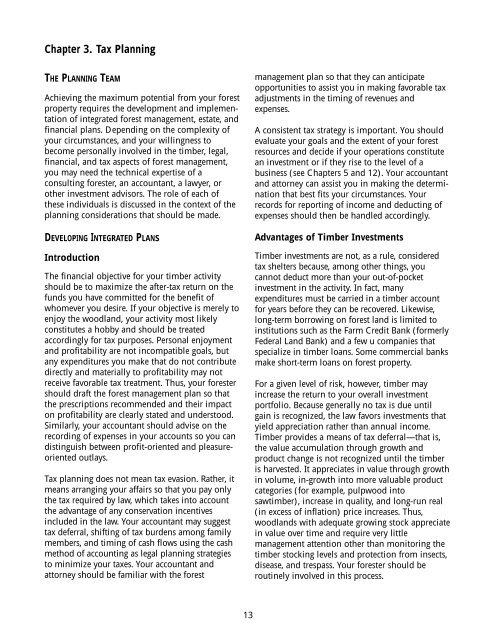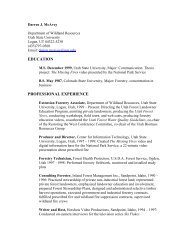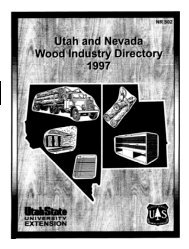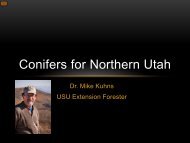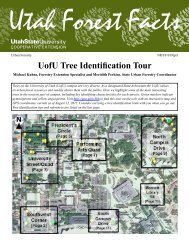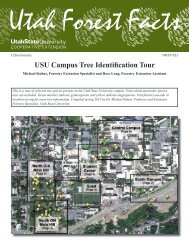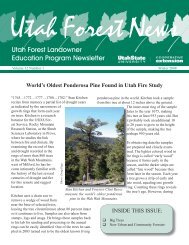Chapter 3. Tax Planning - National Timber Tax
Chapter 3. Tax Planning - National Timber Tax
Chapter 3. Tax Planning - National Timber Tax
Create successful ePaper yourself
Turn your PDF publications into a flip-book with our unique Google optimized e-Paper software.
<strong>Chapter</strong> <strong>3.</strong> <strong>Tax</strong> <strong>Planning</strong><br />
THE PLANNING TEAM<br />
Achieving the maximum potential from your forest<br />
property requires the development and implementation<br />
of integrated forest management, estate, and<br />
financial plans. Depending on the complexity of<br />
your circumstances, and your willingness to<br />
become personally involved in the timber, legal,<br />
financial, and tax aspects of forest management,<br />
you may need the technical expertise of a<br />
consulting forester, an accountant, a lawyer, or<br />
other investment advisors. The role of each of<br />
these individuals is discussed in the context of the<br />
planning considerations that should be made.<br />
DEVELOPING INTEGRATED PLANS<br />
Introduction<br />
The financial objective for your timber activity<br />
should be to maximize the after-tax return on the<br />
funds you have committed for the benefit of<br />
whomever you desire. If your objective is merely to<br />
enjoy the woodland, your activity most likely<br />
constitutes a hobby and should be treated<br />
accordingly for tax purposes. Personal enjoyment<br />
and profitability are not incompatible goals, but<br />
any expenditures you make that do not contribute<br />
directly and materially to profitability may not<br />
receive favorable tax treatment. Thus, your forester<br />
should draft the forest management plan so that<br />
the prescriptions recommended and their impact<br />
on profitability are clearly stated and understood.<br />
Similarly, your accountant should advise on the<br />
recording of expenses in your accounts so you can<br />
distinguish between profit-oriented and pleasureoriented<br />
outlays.<br />
<strong>Tax</strong> planning does not mean tax evasion. Rather, it<br />
means arranging your affairs so that you pay only<br />
the tax required by law, which takes into account<br />
the advantage of any conservation incentives<br />
included in the law. Your accountant may suggest<br />
tax deferral, shifting of tax burdens among family<br />
members, and timing of cash flows using the cash<br />
method of accounting as legal planning strategies<br />
to minimize your taxes. Your accountant and<br />
attorney should be familiar with the forest<br />
management plan so that they can anticipate<br />
opportunities to assist you in making favorable tax<br />
adjustments in the timing of revenues and<br />
expenses.<br />
A consistent tax strategy is important. You should<br />
evaluate your goals and the extent of your forest<br />
resources and decide if your operations constitute<br />
an investment or if they rise to the level of a<br />
business (see <strong>Chapter</strong>s 5 and 12). Your accountant<br />
and attorney can assist you in making the determination<br />
that best fits your circumstances. Your<br />
records for reporting of income and deducting of<br />
expenses should then be handled accordingly.<br />
Advantages of <strong>Timber</strong> Investments<br />
<strong>Timber</strong> investments are not, as a rule, considered<br />
tax shelters because, among other things, you<br />
cannot deduct more than your out-of-pocket<br />
investment in the activity. In fact, many<br />
expenditures must be carried in a timber account<br />
for years before they can be recovered. Likewise,<br />
long-term borrowing on forest land is limited to<br />
institutions such as the Farm Credit Bank (formerly<br />
Federal Land Bank) and a few u companies that<br />
specialize in timber loans. Some commercial banks<br />
make short-term loans on forest property.<br />
For a given level of risk, however, timber may<br />
increase the return to your overall investment<br />
portfolio. Because generally no tax is due until<br />
gain is recognized, the law favors investments that<br />
yield appreciation rather than annual income.<br />
<strong>Timber</strong> provides a means of tax deferral—that is,<br />
the value accumulation through growth and<br />
product change is not recognized until the timber<br />
is harvested. It appreciates in value through growth<br />
in volume, in-growth into more valuable product<br />
categories (for example, pulpwood into<br />
sawtimber), increase in quality, and long-run real<br />
(in excess of inflation) price increases. Thus,<br />
woodlands with adequate growing stock appreciate<br />
in value over time and require very little<br />
management attention other than monitoring the<br />
timber stocking levels and protection from insects,<br />
disease, and trespass. Your forester should be<br />
routinely involved in this process.<br />
13
<strong>Timber</strong> property may serve as an inflation hedge<br />
because it provides considerable flexibility in<br />
harvest timing. This is illustrated in Figure 3-1 with<br />
a stand that can be harvested within 3 to 5 years<br />
prior to or after an optimum rotation determination,<br />
with a minimum amount of potential<br />
income foregone (a detailed discussion is found<br />
on page 15). Furthermore, income realization can<br />
be timed to meet cash needs or tax considerations<br />
because, within limits, cutting can be delayed or<br />
accelerated—thus affecting income and/or tax<br />
liability in a given tax year. The marginal tax rates<br />
for the years to which or from which income is<br />
shifted must be considered.<br />
For highly appreciated timber property (low basis),<br />
recognition of income often can be deferred for<br />
income tax purposes until retirement. Short-term<br />
cash needs can be accommodated more effectively<br />
by borrowing with the woodland as collateral than<br />
by a sale. Although timber is somewhat illiquid, it<br />
may provide a financial reserve to meet cash needs.<br />
Both your forester, who can determine the<br />
optimum timing of timber cutting for given<br />
assumptions about cost and revenues, and your tax<br />
accountant, who can advise as to the tax impacts<br />
of various management alternatives, should be<br />
involved in this process.<br />
Estate <strong>Planning</strong> Role<br />
<strong>Timber</strong> can be used as the component of a portfolio<br />
designed to accumulate wealth for transfer to heirs.<br />
You may want to arrange your affairs to minimize<br />
liability for estate and other transfer taxes. Thus,<br />
forest land often is a good candidate for a shortterm<br />
trust or intergenerational joint ownership.<br />
Forest property also is a good candidate for a family<br />
gifting program to reduce the gross estate value to<br />
less than the Federal estate tax threshold. There are<br />
other advantages for using timber as a gift,<br />
including situations where it is desired to spread<br />
income tax liability among family members. Gifts,<br />
however, have one key disadvantage in addition to<br />
loss of control. Gifted property retains the donor’s<br />
basis, which often is quite low, as opposed to the<br />
step-up in basis for property passed at death. If a gift<br />
tax has been paid, the donee’s basis sometimes may<br />
be increased by part of the amount of tax paid. Your<br />
attorney and accountant should be consulted on the<br />
tax consequences of specific actions and on their<br />
overall impact on your estate planning.<br />
The tax liability of a family can be minimized in<br />
many cases by shifting income from family<br />
members in higher tax brackets to those in lower<br />
brackets through gifts of income-producing<br />
property. The Uniform Gifts to Minors Act facilitates<br />
income shifting. Under the act, a gift of intangibles<br />
can be made to a minor, with the parent who made<br />
the gift serving as custodian. State law allows the<br />
custodian to manage the assets provided there is no<br />
commingling of the child’s income with the parent’s<br />
property. Such planning is limited by the tax<br />
liability calculation for a child under the age of 14.<br />
Your accountant can help evaluate the tax<br />
implications of various gift alternatives.<br />
Forest land estates may qualify for special use<br />
valuation (Section 2032A of the Internal Revenue<br />
Code (Code)), deferral and extension of estate tax<br />
payments (Section 6166), and the family business<br />
deduction (Section 2057). <strong>Timber</strong>, as a renewable<br />
resource, often can provide funds to meet transfer<br />
tax liabilities without having to liquidate<br />
nonrenewable family business assets. Your forester<br />
can assist in the valuation of woodland assets for<br />
special use valuation and your attorney or tax<br />
accountant, or both, can assist in making the<br />
appropriate elections.<br />
<strong>Planning</strong> Implications<br />
Various timber characteristics lend themselves to<br />
specific planning implications. Deferral of income<br />
is an example. The trees generally increase in<br />
volume (quantity) and value annually, but the<br />
increase in value is not recognized until the trees<br />
are harvested.<br />
Substantial Initial Investment. The acquisition<br />
of woodland generally requires a substantial initial<br />
investment with little possibility of immediate cost<br />
recovery, unless merchantable timber is acquired.<br />
For example, purchase of forest land includes a<br />
bare land value at an average cost of $500 per acre.<br />
If not stocked, reforestation costs can vary from<br />
$100 to $300 per acre depending on site index<br />
(productivity), operability, and other factors. To<br />
minimize the time over which such costs must be<br />
carried, you should ensure that the proper portion<br />
of the available basis is allocated to each asset<br />
account (<strong>Chapter</strong> 5), amortize qualified<br />
reforestation expenditures (<strong>Chapter</strong> 5), and claim<br />
the reforestation investment tax credit (<strong>Chapter</strong> 5).<br />
14
The costs allocated to timber basis that cannot be<br />
amortized usually will be recovered only as the<br />
timber matures and is sold (see Figure 3-1).<br />
Figure 3-1 illustrates several points. First, land<br />
expectation value (LEV, the net present value for a<br />
perpetual series of timber crops) calculations are<br />
plotted for a 6-percent cost of capital (the<br />
landowner’s alternative rate of return) at 5-year<br />
intervals for loblolly pine on an average site in the<br />
South. The inputs are establishment costs of $200<br />
per acre, annual property tax and management<br />
costs of $7 per acre, no-thin harvest revenues based<br />
on prices of $29 per cord for pulpwood and $315<br />
per MBF, Scribner log rule, for sawtimber, with<br />
yields estimated using PCWTHIN,1 a computer<br />
growth and yield model for loblolly pine<br />
developed by the growth and yield cooperative of<br />
the Virginia Tech Department of Forestry. For these<br />
assumptions the optimum rotation length is 30<br />
years, which yields an LEV of $396 per acre.<br />
Second, the liquidation curve shows the<br />
merchantable volume that could be harvested over<br />
time from an acre planted to loblolly pine times<br />
the prevailing price for these particular<br />
assumptions. <strong>Timber</strong> production is assumed to be<br />
the highest and best use for the land. Even in this<br />
simple example, timber production is a capital<br />
intensive undertaking that involves land,<br />
establishment costs necessary to obtain adequate<br />
growing stock, and annual operating costs that<br />
must be committed to for long periods of time.<br />
Finally, the internal rate of return is determined in<br />
this special case for the assumed inputs and the 30-<br />
year rotation. The IRR of 8.87 is used to compound<br />
the establishment costs and annual management<br />
costs forward where they are plotted to form the<br />
cost (C/I) curve shown in Figure 3-1. Similarly,<br />
harvest revenues could be discounted subtracting<br />
the annual management cost to get an income<br />
(C/I) curve. This is an imaginary curve that traces<br />
Figure 3-1. Timing of investment, annual management expenses, and harvest revenues, per acre.<br />
1 Weih, R. C., Jr., J. A. Scrivani, and H. E. Burkhart. 1990. PCWTHIN Version 2.0 User’s Manual. School of Forestry and<br />
Wildlife Resources. Virginia Polytechnic Institute and State University, Blacksburg, Virginia. 31 p.1<br />
15
the value of land and timber at any intermediate<br />
point in the rotation between establishment and<br />
harvest. Note that LEV maximizes returns to the<br />
land while IRR maximizes returns to invested<br />
capital. If IRR rather than LEV had been used to<br />
determine rotation length, the optimum rotation<br />
would have been approximately 27.5 years. The<br />
cost/income curve and liquidation curve reach a<br />
point of tangency at age 30 in Figure 3-1 because<br />
for this example IRR was calculated for the 30-year<br />
rotation indicated by LEV.<br />
On either side of the optimum rotation in Figure<br />
3-1, the C/I curve, which represents the potential<br />
income for the optimum, deviates only moderately<br />
in vertical distance from the liquidation curve,<br />
which represents the actual revenue that would be<br />
generated everywhere except at the optimum. This<br />
illustrates graphically that there is a decision<br />
window of several years to schedule a harvest.<br />
Because foregone potential income is small within<br />
3 to 5 years of the optimum rotation, you can<br />
schedule a harvest within that period to meet other<br />
personal goals with only a small sacrifice in<br />
potential income.<br />
Good forest valuation and accounting information<br />
is necessary for effective planning. Your forester<br />
can generate the valuation information, and your<br />
accountant can see that the proper allocation is<br />
made to the original basis in the appropriate<br />
capital accounts.<br />
Long Preproductive Period. Consider<br />
structuring your timber activity to allow the<br />
deduction of qualified expenses against other<br />
(nontimber) income where appropriate. This<br />
usually involves organizing the woodland as a<br />
business, with material participation on your part<br />
(<strong>Chapter</strong> 5). Early payment of expenses at the end<br />
of the tax year accelerates the benefit of the<br />
deduction. Otherwise, try to acquire forest land<br />
with a good distribution of timber age classes.<br />
TAX CONSIDERATIONS WHEN<br />
FOREST LAND IS ACQUIRED<br />
It may be helpful for you to develop and maintain<br />
in your files a management plan documenting your<br />
intention to manage the property for profit, and to<br />
include an estimate of projected profit. Your forester<br />
should be able to make this projection routinely as<br />
part of the management or estate plan. Establish<br />
accounts to which the costs of acquisition—or<br />
values associated with acquisition if the property is<br />
inherited—are allocated according to the relative<br />
fair market value of each component of the property<br />
acquired. Do so while the information is readily at<br />
hand (see <strong>Chapter</strong>s 5 and 15). You should file for<br />
property tax relief if special forest property tax laws<br />
exist in your State.<br />
Both your forester and tax accountant should be<br />
involved in identifying and incorporating these<br />
opportunities in ways that are most advantageous<br />
with regard to your long-term goals. Your forester<br />
and accountant should coordinate the timing of the<br />
revenues as well as the treatment of all costs, as<br />
discussed above. Finally, planning is a dynamic<br />
activity that must keep abreast of your family<br />
situation, the economy, and tax law changes. Your<br />
advisors should be included in all phases of the<br />
process to help you fully realize your goals for your<br />
woodland property.<br />
TAX CONSIDERATIONS<br />
WHEN SELLING TIMBER<br />
Maximize after-tax income by taking all allowable<br />
deductions against timber sale proceeds. Report net<br />
timber income as a long-term capital gain if it<br />
qualifies (<strong>Chapter</strong> 6). Unlike ordinary income,<br />
capital gains are not subject to the self-employment<br />
tax (<strong>Chapter</strong> 10). Also, if you are retired, capital gains<br />
do not count toward the amount of income you can<br />
receive before your Social Security benefits are<br />
reduced (<strong>Chapter</strong> 10). Consider deferring receipt of a<br />
portion of the sale proceeds, but only if the resulting<br />
tax saving exceeds the opportunity cost of not having<br />
use of the deferred funds (see <strong>Chapter</strong>s 2 and 10).<br />
16


